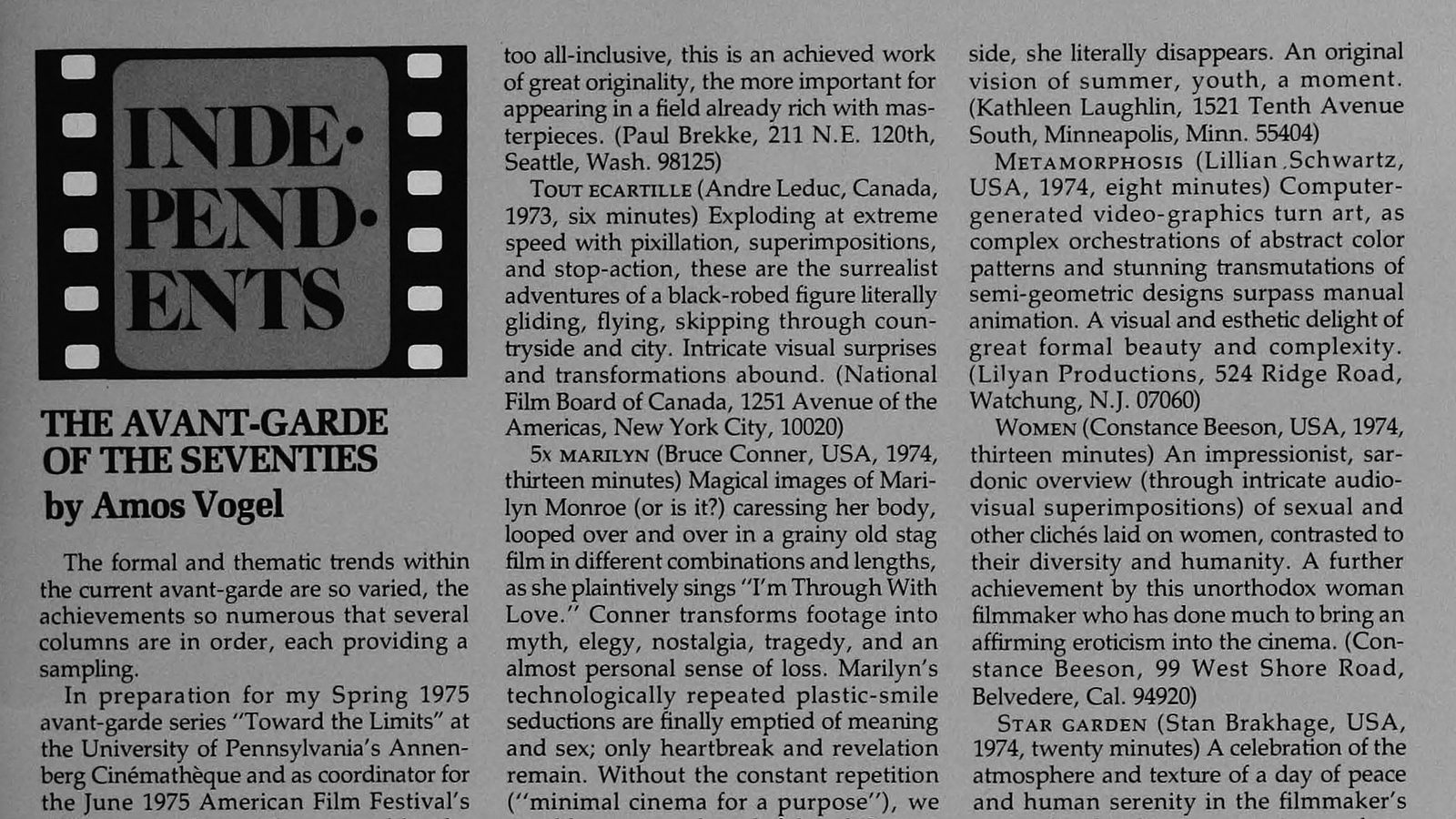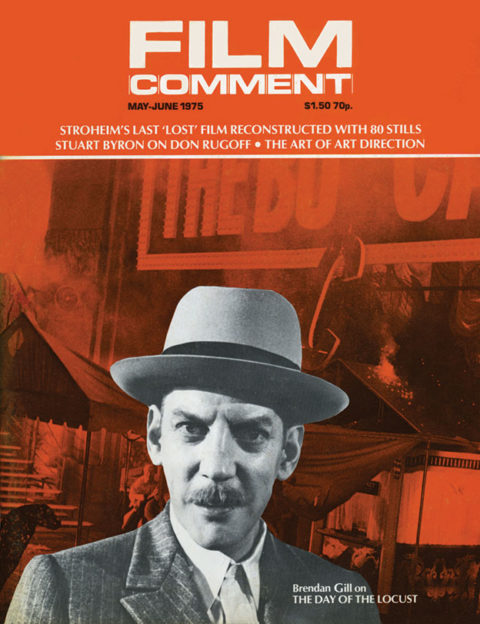By Amos Vogel in the May-June 1975 Issue

Independents: The Avant-Garde of the Seventies
The variety of formal and thematic trends within the current avant-garde
The formal and thematic trends within the current avant-garde are so varied, the achievements so numerous that several columns are in order, each providing a sampling.

From the May-June 1975 Issue
Also in this issue
Interview: Dusan Makavejev
By Edgardo Cozarinsky and Carlos Clarens
In preparation for my Spring 1975 avant-garde series “Toward the Limits” at the University of Pennsylvania’s Annenberg Cinematheque and as coordinator for the June 1975 American Film Festival’s “Film As Art” event (sponsored by the Educational Film Libraries Association), recent screenings of over three hundred titles have reassured me of the movement’s continued striving to extend the borders of the possible and the incursion of the modern world view and modern art into a medium reluctant to enter the twentieth century. I am also reassured that the “formal cinema”—while a significant component of the avant-garde—is not its “equivalent” (there exist the most diverse tendencies of merit); that viewing films without narratives can be spectacularly enriching; that the vitality and creativity of certain famed avant-gardists (imperceptibly becoming older statesmen) continues, as do surrealism, expressionism, abstraction; that requirements of artistic excellence are increasingly met in video and computer films; and that, negatively and positively, all tendencies continue to reflect or undermine social values (whether their makers know it or not). All represent an invitation. Whether you accept it (or rather, open yourself to it), is up to you. The work—the revelation—is there, waiting.
What follows are the titles chosen for the American Film Festival event: these films can be obtained either from the individual sources listed, or, if you are an EFLA member or represent a university, as a package for no-admission showings from: EFLA, 17 West 60th Street, New York, NY 10023.
DISPARATES (Paul Brekke, USA, 1974, eleven minutes) Abstract study of hundreds of often unidentifiable objects from nature, so complex in structure and visual manipulation, so rich in technique and rapid in tempo that it defies verbal description rather successfully. Though perhaps too all-inclusive, this is an achieved work of great originality, the more important for appearing in a field already rich with masterpieces. (Paul Brekke, 211 N.E. 120th, Seattle, Wash. 98125)
TOUT ECARTILLE (Andre Leduc, Canada, 1973, six minutes) Exploding at extreme speed with pixillation, superimpositions, and stop-action, these are the surrealist adventures of a black-robed figure literally gliding, flying, skipping through countryside and city. Intricate visual surprises and transformations abound. (National Film Board of Canada, 1251 Avenue of the Americas, New York City, 10020)
5x MARILYN (Bruce Conner, USA, 1974, thirteen minutes) Magical images of Marilyn Monroe (or is it?) caressing her body, looped over and over in a grainy old stag film in different combinations and lengths, as she plaintively sings ”I’m Through With Love.” Conner transforms footage into myth, elegy, nostalgia, tragedy, and an almost personal sense of loss. Marilyn’s technologically repeated plastic-smile seductions are finally emptied of meaning and sex; only heartbreak and revelation remain. Without the constant repetition (“minimal cinema for a purpose”), we would not grow thoughtful and Conner could not have transformed (revealed) the heroine as wind-up toy for a nation. (Serious Business Company, 1608 Jaynes Street, Berkeley, Calif. 94703)
TESTAMENT (James Broughton, USA, 1974, twenty minutes) A wise, gentle, accepting statement about life and (definitely) death by an American master of poetic cinema whose work now spans several avant-gardes, yet grows ever more mature. Told in free form, with beautiful, bemused poetry by the filmmaker weaving in and out of childhood images, his former films used as proto-documentary materials, and live action shot today. The ending—a marvelous, magical presentiment of his death—reaches the level of myth. (Serious Business Company, see above)
SUSAN THROUGH CORN (Kathleen Laughlin, USA, 1974, two minutes) A poetic, yet formal study of a young woman in. red-yellow dress, running through a very green field, followed by single-frame camera which, with stalks of corn in front and sky-brightness overhead, serves to bisect and abstractify her. Emerging on the other side, she literally disappears. An original vision of summer, youth, a moment. (Kathleen Laughlin, 1521 Tenth Avenue South, Minneapolis, Minn. 55404)
METAMORPHOSIS (Lillian.Schwartz, USA, 1974, eight minutes) Computergenera ted video-graphics turn art, as complex orchestrations of abstract color patterns and stunning transmutations of semi-geometric deSigns surpass manual animation. A visual and esthetic delight of great formal beauty and complexity. (Lil yan Productions, 524 Ridge Road, Watchung, N.J. 07060)
WOMEN (Constance Beeson, USA, 1974, thirteen minutes) An impressionist, sardonic overview (through intricate audiovisual superimpositions) of sexual and other cliches laid on women, contrasted to their diversity and humanity. A further achievement by this unorthodox woman filmmaker who has done much to bring an affirming eroticism into the cinema. (Constance Beeson, 99 West Shore Road, Belvedere, Cal. 94920)
STAR GARDEN (Stan Brakhage, USA, 1974, twenty minutes) A celebration of the atmosphere and texture of a day of peace and human serenity in the filmmaker’s warm, lived-in house, centering on faces and movements of his children, rooms and objects of a poet’s existence transformed by shafts and tones of light. Stylistically, poetic fragmentation and abstractification remain (complex montage, choreographed camera movements, changing camera setups and speeds); but there is also a continued turning back by a master formalist to the human element, an evolution already evident in his autopsy film, TO SEE WITH ONE’S OWN EYES (Film-makers Coop, 175 Lexington Avenue, New York City 10016)
FUJI (Robert Breer, USA, 1974, eight minutes). A poetic, lyrical, rhythmic, riveting achievement (in rotoscope and abstract animation), in which fragments of landscapes, passengers, and train interiors blend into a magical color dream of a voyage. One of the most important works by a master who—like Conner, Brakhage, Broughton—spans several avant-gardes in his ever more perfect explorations. (Film-Makers Coop, see above, for rentals; Robert Breer, Palisades, N.Y. 10964, for sales)
More to come.







